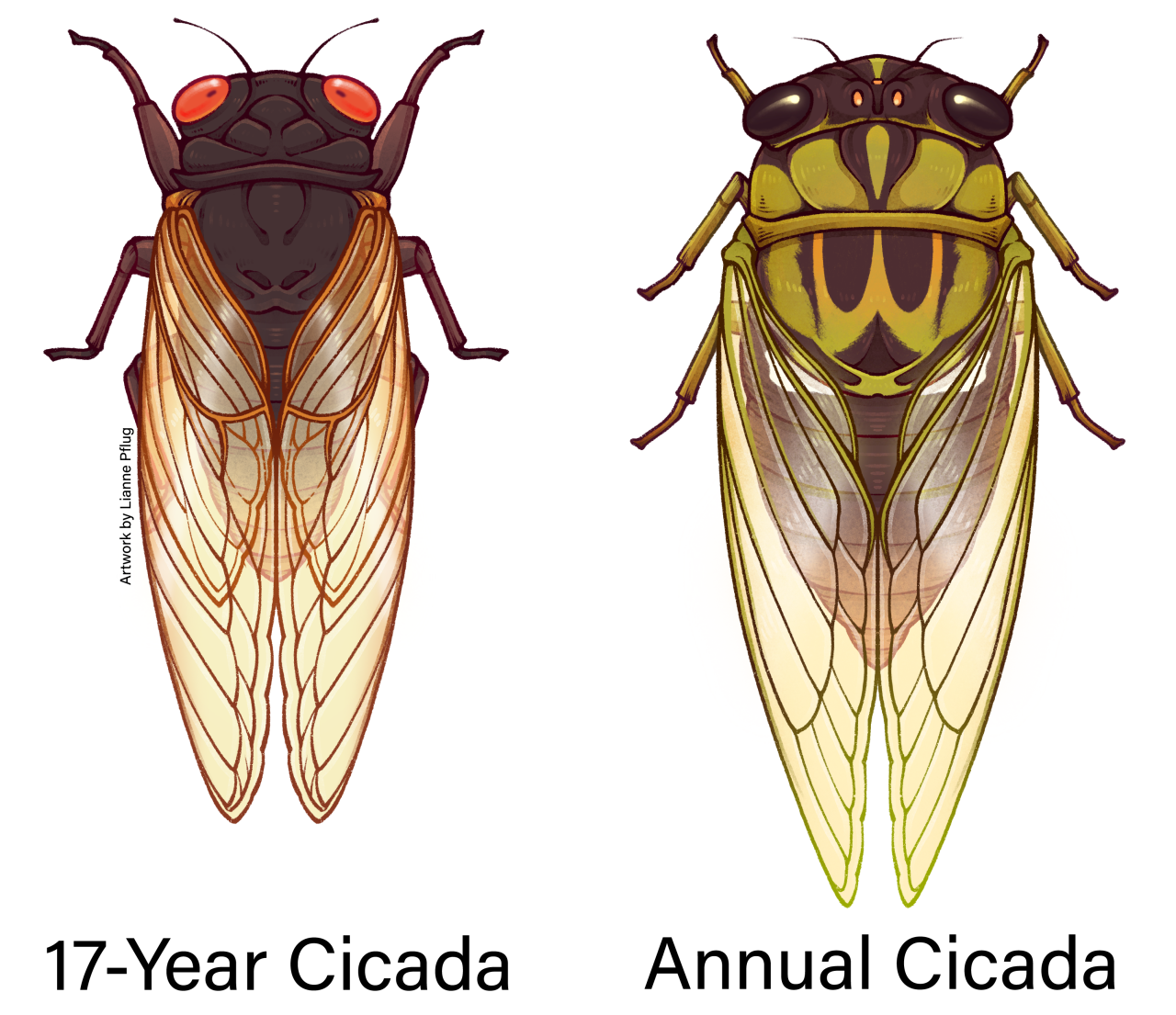INDIANAPOLIS — Trillions of Brood X cicadas are crawling out of their holes, climbing trees and will soon start “singing” a raucous, rattling mating call throughout Indiana and a wide swath of the United States.
With black-shells, red-eyes and translucent golden-veined wings, this special species of cicada emerges in overwhelming numbers just once every 17 years.
Here are some things you should know about these interesting, noisy, creepy and abundant yet rarely experienced insects.

Harmless, mostly
Despite a Darth-Vader-of-the-bug-world appearance, Purdue University entomology educator Elizabeth Barnes said they are harmless to all but the youngest and most delicate trees.
“It’s unfortunate that they look a bit sinister and they're coming out in these huge numbers,” Barnes said. “For the most part they're totally harmless.”
When they lay their eggs in trees, they split the bark on smaller, pencil-sized twigs and branches. Mature trees won’t have any problems, Barnes said.
“They lay their eggs with an ovipositor, which looks like a little like a needle with some serration on it, and they stick that into the trees,” Barnes said. “People might worry and think that their trees are dying, when really the cicadas are basically giving them a little light pruning.”
Nets are better than chemicals
Don’t use pesticides, Barnes said, because you’ll kill butterflies, ladybugs and a host of beneficial bugs.
“Cover (small trees) in insect netting and that'll keep the cicadas off,” Barnes said. “It's actually cheaper and more effective than insecticide.”
Cicadas won’t hurt people or pets.
“They don't bite, they don't sting, they're not poisonous,” Barnes said. “They don't have any real defenses against predators.”
Holes in the ground
Cicada nymphs hatch from eggs that are laid in trees then burrow down into the dirt where they feed off the roots.
Brood X nymphs stay underground for 17 years before they emerge to reproduce, University of Connecticut entomologist Chris Simon explained in a Twitter post designed to help journalists correctly report on the insects.
When they emerge, they leave holes in the ground that scientists say helps aerate the soil.

Can’t eat them all
Cicadas will be a buffet for birds, bats, rodents and predatory bugs over the coming weeks. With so many cicadas, Barnes said the predators can’t eat them all.
“The way that they're defending themselves against predators is by emerging in such huge numbers,” Barnes said.
They'll only be around for about six weeks, Barnes said. Then it will be 17 years before we see the next generation of Brood X.
Different than annual cicadas
Brood X is a different species of cicada than the greenish-bodied, black-eyed bugs we see and hear annually later in the summer.
“It's kind of like a chicken versus a pigeon,” Barnes said. “They're similar. They're both birds but they do very different things at very different times.”

That's “Brood T-E-N”
Scientists call them “Brood 10,” but even the experts slip sometimes.
“The Brood X (ekks) is a specific,” Barnes said, catching herself. “Brood 10. Oh goodness. It’s supposed to be Brood 10 but Brood X sounds much cooler. So many people say that and I’m doing it too.”
Emerging in 15 states
Brood X, is sometimes called “The Great Eastern Brood” and covers one of the largest geographic areas of any cicada species, according to the University of Connecticut.
They spread east from Illinois to New York, and south to Georgia. Millions will emerge in Indiana. Expect to find them around Indianapolis and in forested areas in the southern parts of the state.
Zombie cicadas
Yep, you read that right. Zombies.
There’s a cicada-killing fungus that turns the already creepy-looking creatures into something truly horrifying, Barnes said.
“It essentially converts their entire abdomen into fungal spores,” Barnes said. “It looks like there's a cotton ball stuck at the end of their body.”
The fungus kills and takes over the bodies of the host cicadas, Barnes said. It makes male cicadas stop buzzing and produce the snapping sounds typically made by females. Then it infects the other males who try to mate.
“It produces chemicals that make the cicadas basically still be active and still be moving around, even though they're like, falling apart,” Barnes said.
Similar parasites attack caterpillars and other insects, Barnes said.

There’s also a species of cicada-killing wasps that paralyzes and lays eggs into the bugs before burying them, according to the University of Kentucky entomology department. The cicada bodies become food for wasp larvae.
"You know the movie "Alien"?" Barnes said. "Well, guess what, that's real for insects."
Talk about nightmare fuel.
You can help
Hoosiers can use a smart phone to help scientists track and monitor cicadas that emerge in Indiana, Barnes said.
The Cicada Safari app is part of a years-long national project to map and plot various broods of cicadas. Developed by Mount St. Joseph University in Cincinnati, Ohio, it allows users to upload photos and view the sightings on a map.

By Wednesday, eight Cicada Safari users had uploaded 13 photos of cicadas taken on the east side of Indianapolis. In Bloomington, the Cicada Safari app showed 30 users had uploaded 54 cicada pictures by Wednesday.
You can also use the iNaturalist app to join the "Indiana Cicada Fest" to contribute to a "Bio Blitz" project being conducted by Purdue University.
"For a Bio Blitz, basically, people go out and they take pictures of everything that they can find, every living thing," Barnes said, "That goes into iNaturalist and we will use the cicada data, and the other photos that they take will be added to other projects as well."
Contact WRTV reporter Vic Ryckaert at victor.ryckaert@wrtv.com or on Twitter: @vicryc.




